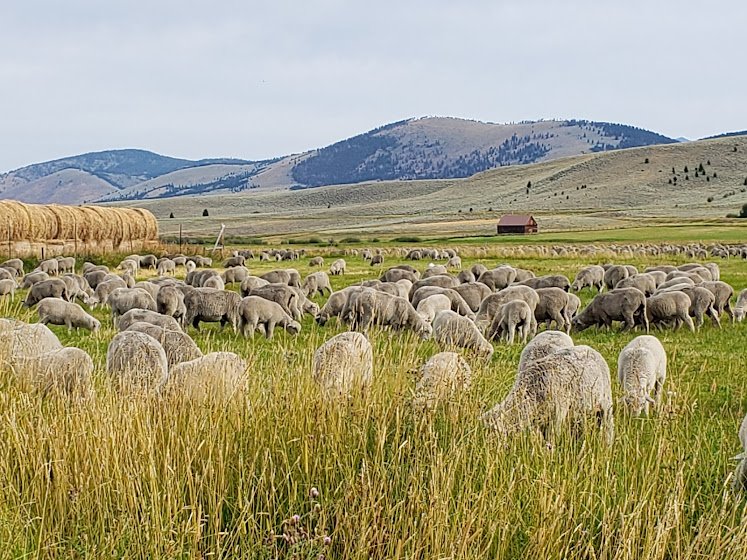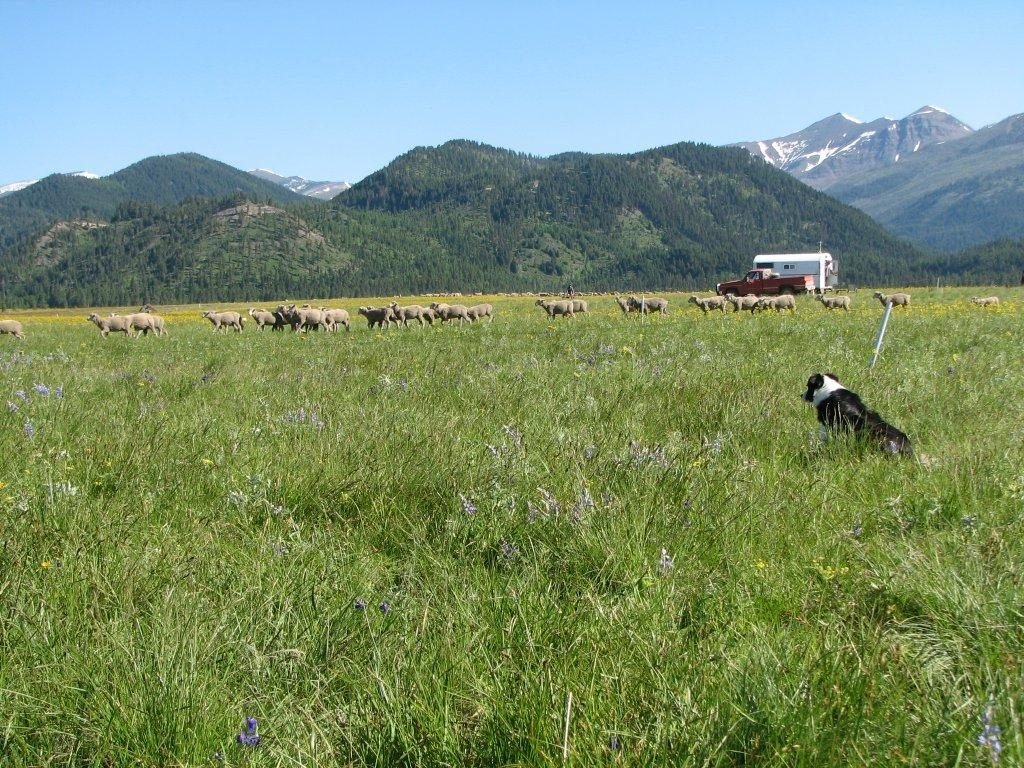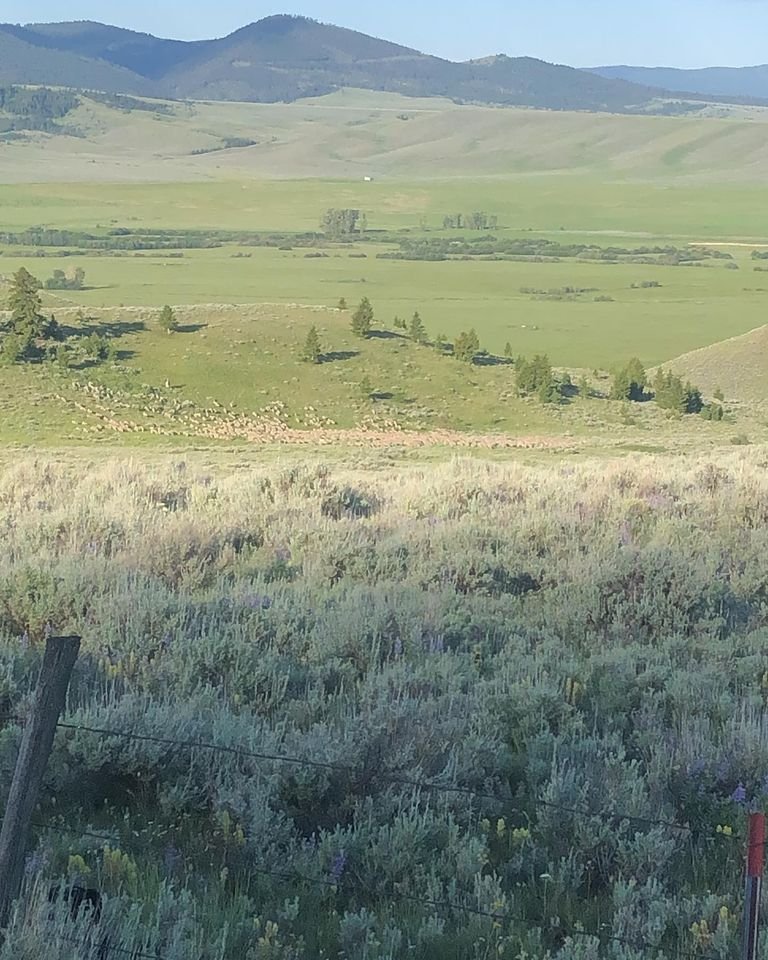Sheep grazing, weed management, and playing the long game
A few weeks ago we hosted an ESAP tour, part of the Environmental Stewardship award we received last year. It may be funny to say, but I learned more about our operation while taking part in it. It also reminded me of plenty of things we’d love to be able to share with our customers and others who haven’t had the chance to attend a tour like that. One of those topics was our 23 year sheep grazing experiment.
On the tour my dad, David Mannix, and Dan Lucas, an extension agent who worked with us to design and monitor the sheep grazing project, stood up to share lessons learned over the course of the 20 year experiment. Dan began by describing why knapweed is such a challenge. As an introduced non-native species, knapweed lacks many of the natural pests and predators that held it in check in its native habitat. It flowers for an extended period of time, which allows it to produce large amounts of seeds, and spread rapidly. Its extensive root system helps it access water from deeper soil layers, making it more drought-tolerant compared to many native species. In can thrive in many types of soil, including poor, shallow soils and especially disturbed soils. It is also allelopathic, releasing chemicals that inhibit neighboring plants.
Knapweed infestation
Knapweed can come to dominate pastures, reducing diversity, forage production, and soil health for wildlife and cattle alike. And that is of course why ranchers and government agencies have been battling the weed through a combination of chemical sprays, mowing, pulling, insect releases, and more for many years. But herbicides of course kill more than just the knapweed plants they are intended for, and have plenty of negative side effects. All of these types of control are also expensive, and the fact that knapweed is so widespread means that pulling, mowing, and spraying weeds becomes uneconomical pretty quickly. Insect releases, while probably a good step and something that we have tried, are slow to take hold and so far haven’t been enough to bring the weed under control. So what other options do we have?
In 2000, our ranch began experimenting with controlling knapweed through grazing. For the first three years it was with a band of goats owned by a producer in augusta, before moving to a partnership with Sieben Livestock Company, and finally Sieben Ranch to bring a band of sheep. Now each summer the herders for Sieben ranch trail a little over 1000 ewes and their lambs over the mountains to the ranch, where they graze for two months in July and August. Sieben sends a Peruvian herder with the sheep that lives with the band of sheep, and herds them expertly from knapweed patch to knapweed patch, targeting the blooming knapweed blossoms and then leaving quickly, before the sheep put much pressure on native grasses.
Dad talked about how for the first 4 years, we were alarmed to see more knapweed plants, both visually in the pasture and in our monitoring plots. However, scientists with the NRCS and MSU, who were helping us to design and monitor the grazing, thought that what they were seeing was less wolfy, mature knapweed plants, and more juvenile knapweed seedlings. Because knapweed seeds can remain viable for as long as 13 years in the soil they encouraged us to continue. By year 8, we were back to where we had started for knapweed plants in most of our plots, by year 13, the knapweed was vastly reduced in targeted pastures, and virtually gone from our monitoring plots! There are certainly still knapweed plants out there, with a few areas worse than others. And even if we could eliminate it, we would constantly see knew infestations invading from roads or neighboring properties. But it does feel like the infestation is under control in the area we’ve been targeting it with grazing, and knapweed there is not dominating whole hillsides and displacing native vegetation.
What are some of the lessons learned? First of all, skilled herding makes a big difference. We owe a huge thanks to the Peruvian herders employed by the Sieben ranch and Sieben livestock who lived with the sheep and expertly maneuvered the sheep around to target patches of knapweed, applying enough pressure to impact most knapweed blossoms, but leaving soon enough that they put very little grazing pressure on native bunch grasses. We found it was important to graze knapweed blossoms after early July, because after that point a new blossom may still form, but in our climate the plants didn’t have time to regrow viable seeds.
It highlights the importance of partnerships. Without guidance from Dan Lucas and others at MSU, we likely wouldn’t have started this project. We needed help from range scientists in designing and monitoring the grazing project. That monitoring, which helped show the changing age of the knapweed plants present, and the knowledge of long term seed viability helped give us the confidence to stick with it. We also didn’t have our own sheep, and didn’t have skilled herders, so partnering with Sieben ranch was important as well.
Maybe most importantly, it reinforces how important it is to have long time horizons when managing land. This has been a 20 year experiment for us, it took 13 years to truly see the knapweed plants nearly eliminated from the system. That is a long time to wait to see results. Not only that, but then at the end of this, it was mostly sagebrush that had moved back in to the system, so it took additional years with some controlled burns and other sagebrush treatments to get to a more productive pasture with more native grasses.
I actually think this is one good argument for why we should care about generational family ranches. I’m not saying that corporate ranches, or property managers who are leasing ground couldn’t do things like this, but it is tough to invest the time and money unless you are confident you can stick with it for the long term. Family ranches, who own their land and have future generations in mind, have extra incentive to play the long game. I can testify to this firsthand, as we are admittedly slower to do some of these investments in time and infrastructure to improve management on land that we lease, vs land we own.
Speaking of thinking about the long game, this gets me thinking about what the “long game” is with noxious weeds. I love the Seven generations principle, or the Iroquois idea that when we make decisions today we should imagine the impact they will have 7 generations in the future. If I look forward 7 generations, I have no hope that knapweed, or other noxious weeds will be eliminated entirely. And even if they were, other invasive species would likely be introduced. But it would be a failure if we were still a war with the weeds, expending valuable time and money combating them with herbicides, pulling, tilling, etc.
Knapweed can definitely have negative impacts on ecosystems when it takes over, but Dan went on to explain on the tour that sheep that have learned to graze knapweed will actually seek out the knapweed blossoms because they maintain higher protein later into the grazing season, and may be higher in nutrients as well. And when you consider that with some of knapweed’s other characteristics, “Extensive root system to access water from deeper soil layers, drought tolerant, thrives in poor, shallow, and disturbed soils, etc,” it’s not hard to imagine that knapweed isn’t entirely bad. If we can re-frame weeds, we sometimes realize they are filling important roles in ecosystems, and usually when they take over, something is out of balance.
Wouldn’t it be much better if we learned to manage and graze in a way that didn’t eliminate knapweed, but turned it into just another plant on the landscape. One that established living routes in otherwise bare disturbed soils. One that could provide some extra protein and nutrients to grazing animals like sheep or deer late in the season. One that didn’t take over pastures because soils were healthy and less disturbed, and because some combination of naturally occuring predators and grazing pressure held it in check. We certainly aren’t there yet, but this experiment gives me hope that we can head in that direction.







